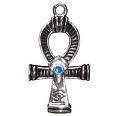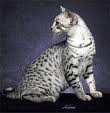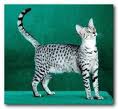Key Terms in Ancient Egypt

This amulet is the Egyptian
symbol of life.
Amulet
A small object that an Egyptian wore, carried or offered to a deity in the belief it would bestow them a specific power or form of protection. In Early Egypt, these were animal forms. But in later dynasties, the animals were replaced by human forms, then those of deities. Often, words spoken or a compound used with the object were the source for magical power it carried that helped grant the person's desire or protection. Sometimes carved or inscribed into jewelry. Amulets were in widespread use, as Egyptian religion was a daily part of life.Book of the Dead
The best known Sacred Text of Ancient Egypt. This text dealt with the journey into the afterlife, giving instructions and spells.Cult
A group of Egyptians who believed in the same deities and shared the same rituals. Many times, particular deities were worshipped by location, such as a "bast (cat-goddess) cult" in a certain city and with a particular temple as the religious center. It is important to note that an Ancient Egyptian cult carries none of the negative sense of the word often used in modern times to indicate followers of an extremist, false belief or led by a charismatic leader.
Hieroglyphs
The signs that were used for writing. A type of picture writing. There are over 700 hieroglyphs.
Kohl painted eyes
Egyptian art depicted heavy eye liner that created an almond-shaped eye. It was used only partly to beautify. In addition, the materials themselves contained disinfectant. The make-up also served magic and spiritual practices.

Mau [Egyptian Mau]
The cat breed depicted in Egyptian art and believed to be the species domesticated by Egyptians. These cats had a role in religion as well as everyday life. They were worshipped as deities, strongly associated with the goddess Bast, and were loved as pets. Cats were powerful protectors. After all, they hunted and killed vermin. They were often mummified and buried in cat cemeteries, with valuable items such as jewelry found buried with them. Maus are small to medium, and are grayish and spotted.Pharaoh
The title used for the ruler of Egypt. The pharaoh was the most powerful Egyptian, and the leader of both politics and religion. Later in Egyptian culture, the pharaohs were believed to be gods present on earth. There is some evidence of a few female pharaohs, all of the royal blood line.Scribes
The Egyptians who received training to write. That meant they had to learn the many hieroglyphs. (Only 1% of the Egyptian population could read and write). Almost all of our known information of Ancient Egypt comes from the writing and art of the scribes.
Temples
The monumental-size stone temples of Egypt were considered to be the dwelling places for the gods and goddesses. Priests performed rituals daily inside the sacred rooms. But they were more than the center of religious activities. Government administration and accounting, festivals, and rooms that served as libraries - all of these being housed in the temple - could lead to the construction of extensions of the main temple such that entire compounds ended up being built. Egyptian people were not allowed inside.



